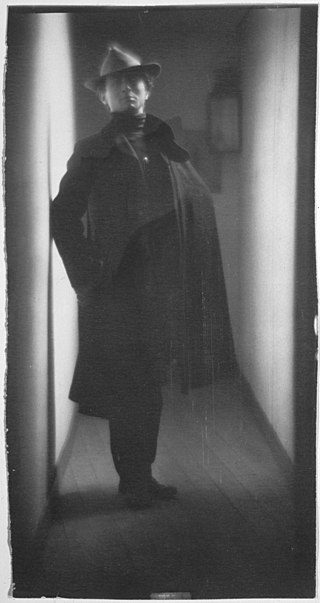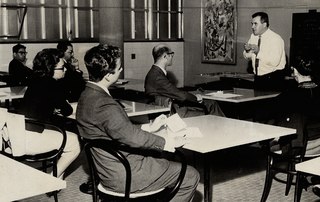Related Research Articles

Edward Jean Steichen was a Luxembourgish American photographer, painter, and curator, renowned as one of the most prolific and influential figures in the history of photography.

The Family of Man was an ambitious exhibition of 503 photographs from 68 countries curated by Edward Steichen, the director of the New York City Museum of Modern Art's (MoMA) department of photography. According to Steichen, the exhibition represented the "culmination of his career". The title was taken from a line in a Carl Sandburg poem.

Otto "Otl" Aicher was a German graphic designer and typographer. Aicher co-founded and taught at the influential Ulm School of Design. He is known for having led the design team of the 1972 Summer Olympics in Munich, and for overseeing the creation of its prominently used system of pictograms. Aicher also developed the Rotis typeface.

The Ulm School of Design was a college of design based in Ulm, Germany. It was founded in 1953 by Inge Aicher-Scholl, Otl Aicher and Max Bill, the latter being first rector of the school and a former student at the Bauhaus. The HfG quickly gained international recognition by emphasizing the holistic, multidisciplinary context of design beyond the Bauhaus approach of integrating art, craft and technology. The subjects of sociology, psychology, politics, economics, philosophy and systems-thinking were integrated with aesthetics and technology. During HfG operations from 1953–1968, progressive approaches to the design process were implemented within the departments of Product Design, Visual Communication, Industrialized Building, Information and Filmmaking.

Clervaux Castle in the town of Clervaux in Northern Luxembourg dates back to the 12th century. Destroyed by the fire in the Second World War during the Battle of the Bulge, the castle has now been fully rebuilt. It houses the commune's administrative offices as well as a museum containing an exhibition of Edward Steichen's photographs.

Hans G. Conrad was a photographer and graphic designer in the 20th century.
Hans (Nick) Roericht, is a German designer. He was professor at the Hochschule der Künste Berlin, Industriedesign IV, from 1973 to 2002. He designed the TC100 stacking tableware for his thesis at the Ulm School of Design in 1959, which was taken into the collection of the Museum of Modern Art in New York.
Humanist Photography, also known as the School of Humanist Photography, manifests the Enlightenment philosophical system in social documentary practice based on a perception of social change. It emerged in the mid-twentieth-century and is associated most strongly with Europe, particularly France, where the upheavals of the two world wars originated, though it was a worldwide movement. It can be distinguished from photojournalism, with which it forms a sub-class of reportage, as it is concerned more broadly with everyday human experience, to witness mannerisms and customs, than with newsworthy events, though practitioners are conscious of conveying particular conditions and social trends, often, but not exclusively, concentrating on the underclasses or those disadvantaged by conflict, economic hardship or prejudice. Humanist photography "affirms the idea of a universal underlying human nature". Jean Claude Gautrand describes humanist photography as:
a lyrical trend, warm, fervent, and responsive to the sufferings of humanity [which] began to assert itself during the 1950s in Europe, particularly in France ... photographers dreamed of a world of mutual succour and compassion, encapsulated ideally in a solicitous vision.
Willi (Willie) Huttig was a German photographer and alpinist.
Rudolf Busler was a German news photographer and cinematographer active from the 1950s to the 1970s.
Leopold Fischer (1902-1978) was an Austrian police officer and much-awarded Pictorialist, and later, Modernist, photographer.
William Vandivert was an American photographer, co-founder in 1947 of the agency Magnum Photos.
Constantin Joffé (1910–1992) was a Russian / French / American fashion and advertising photographer who worked for the magazines Vogue and Glamor in the 1940s and 1950s, during their period of widest circulation.
Hermann Claasen was a German photographer.
Bob Schwalberg was an American photojournalist and writer on photographic technique and equipment.
John Bertolino was an American photojournalist who photographed in Italy and the United States and was active in the 1950s and 1960s.

Herlinde Koelbl is a German photographic artist, author and documentary filmer.
Sam Falk was an Austrian-American photojournalist. He worked for The New York Times from 1925 to 1969, and also contributed to various other publications.
Paul Berg was an American photojournalist for the St. Louis, Missouri Post-Dispatch, and also wrote about the practice of photojournalism.
Helene Nonné-Schmidt was a German professor for art at the Ulm School of Design and a textile artist at the Bauhaus.
References
- ↑ "Hannes Rosenberg (1910–)". Baden-Württemberg Museum digital (in German). Retrieved 2023-01-07.
- ↑ 'I Llove You: a romance in llama lland', photographs by Hannes Rosenberg, The Charlotte Observer Sunday, 16 Aug 1953, p.95
- ↑ Morgan, Willard Detering, 1900-1967 (1949). The Encyclopedia of photography : a complete guide to amateur photography. National educational alliance. Retrieved 22 October 2019.
{{cite book}}: CS1 maint: multiple names: authors list (link) CS1 maint: numeric names: authors list (link) - ↑ Hannes Rosenberg "One Man ... and 8 Parrots". In Foto-Magazin issue 5, 1949, Heering Verlag
- ↑ "Out of the World of the Theater". In Foto-Magazin, Heering Verlag, Seebruck, issue 11/1949
- ↑ Zentner, Kurt & Lohse, Bernd (ed.) Europa-Camera, 1951, pp. 50 and 51
- ↑ Helene Ehman, Die neue Arche With adaptation of words by H. Ch. Andersen, Ausgewählte Märchen, 2 vols., 1947-49 (vol. 1, 5th ed. 1949)
- 1 2 "Interieur van een woonkamer: houten zithoek met met stof beklede kussens, burea…". Nationaal Archief (in Dutch). Retrieved 2019-10-22.
- 1 2 "Hannes Rosenberg at Report digital independent picture library Archive of social history from 1945 onwards". Report digital. Retrieved 2019-10-23.
- ↑ Germany, Süddeutsche Zeitung Photo, DIZ München GmbH, Munich. "Auslieferung der Süddeutschen Zeitung, 50er Jahre". Dokumentations- und Informationszentrum München GmbH (in German). Retrieved 2019-10-23.
{{cite web}}: CS1 maint: multiple names: authors list (link) - ↑ Hannes Rosenberg ‘Through the Iron Curtain’ The New York Times July 27, 1952. Cited in Johnson, Jason B (2017), Divided village : the Cold War in the German borderlands, London New York Routledge Taylor & Francis Group, ISBN 978-0-415-79377-3
- ↑ "A man working on a balloon during a balloon operation in Germany". Getty Images. 10 April 2004. Retrieved 2019-10-22.
- ↑ "Free Europe Press Cold War Leaflets". www.psywarrior.com. Retrieved 2019-10-22.
- ↑ "Using Balloons to Breach the Iron Curtain". RFE/RL. Retrieved 2019-10-22.
- ↑ David J. Haight (2008) Propaganda, Information and Psychological Warfare: Cold War and Hot. A List of Holdings in the Dwight D. Eisenhower Presidential Library
- ↑ William N. Oatis, "Why I Confessed," Life, September 21, 1953, p. 131; p. 141.
- 1 2 3 Steichen, Edward; Sandburg, Carl; Norman, Dorothy; Lionni, Leo; Mason, Jerry; Stoller, Ezra; Museum of Modern Art (New York) (1955). The family of man: The photographic exhibition. Published for the Museum of Modern Art by Simon and Schuster in collaboration with the Maco Magazine Corporation.
- ↑ "Hannes Rosenberg | MoMA". The Museum of Modern Art. Retrieved 2019-10-22.
- ↑ Hurm, Gerd, 1958-, (editor.); Reitz, Anke, (editor.); Zamir, Shamoon, (editor.) (2018), The family of man revisited : photography in a global age, London I.B.Tauris, ISBN 978-1-78672-297-3
{{citation}}:|author1=has generic name (help)CS1 maint: multiple names: authors list (link) CS1 maint: numeric names: authors list (link) - ↑ Sandeen, Eric J (1995), Picturing an exhibition : the family of man and 1950s America (1st ed.), University of New Mexico Press, ISBN 978-0-8263-1558-8
- ↑ "Hannes Rosenberg Vintage Silver Gelatin Photo Print Family of Man ca. 1955 Youth". eBay (in German). Retrieved 2019-10-23.
- ↑ "Leitzianer.de - Die Leica in Beruf und Wissenschaft". www.leitzianer.de. Retrieved 2019-10-22.
- ↑ The political history of the Ulm School of Design (1953-1968) An example of educational and cultural policy in the Federal Republic of Germany Inaugural dissertation to obtain the doctoral degree and the Philosophical Faculty of the University of Cologne presented by Rene Michael Spitz from Rheinbach Euskirchen 1997
- ↑ Spitz, René; Hochschule für Gestaltung (Ulm, Germany) (2002), Hfg Ulm : the view behind the foreground : the political history of the Ulm School of Design 1953-1968, Edition Axel Menges, ISBN 978-3-932565-17-5
- ↑ "Schreibtisch, Arbeitstisch, drei Schränke, ein Regal 'Rosenberg', um 1955". Quittenbaum (in German). Retrieved 2019-10-23.
- ↑ "Artists". Museum Folkwang. Archived from the original on 2021-07-26. Retrieved 2019-10-22.
- ↑ Rosenberg, Hannes and Annelise (1955). "Record in the State Archive: Circus Gebrüder Belli by Hannes and Annalise Rosenberg". Stadtarchiv München.
- ↑ "The Family of Man". Steichen Collections CNA. Retrieved 2019-10-23.